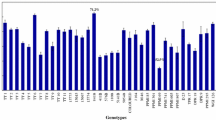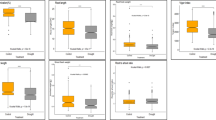Summary
Kabuli chickpea (Cicer arietinum L.) is the common cultivated type of chickpea in arid and semi-arid environments in the Mediterranean region. Ascochyta blight, (Ascochyta rabiei (Pass.) Labr.), leaf miner (Liriomyza cicerina, Rond.) and cold, are the three most important stresses on chickpea grown under semi-arid conditions in this region. Phenotypic frequencies for responses to these stresses in the eight major chickpeagrowing regions of the world were estimated from 5,672 kabuli chickpea accessions assembled from these regions. In addition, the accessions were evaluated for 12 morpho-physiological and three phenological characters under semi-arid Mediterranean conditions at the International Center for Agricultural Research in the Dry Areas (ICARDA), Aleppo, Syria. Considerable regional differences in frequency distributions for response to the three stresses were observed. Average phenotypic diversity for responses to the three stresses was lower (Ho=0.474) than for morpho-physiological (Ho=0.754) and phenological (Ho=0.812) characters. The highest frequencies of accessions resistance to Ascochyta-blight and leaf-miner were found in South Asia and South Central Asia, respectively. A small number of chickpea breeding materials of ICARDA showed a moderate level of tolerance to cold. A group of four characters showing the strongest bivariate association with each of the three stresses was identified from the latter group. Then, a discrete multivariate log-linear analysis of the five-way frequency table was performed for each group. The simplest log-linear model for each group included both two- and three-factor association terms, but no independent factors. This suggested the potential for indirect selection for stress tolerance using one or more of these associated characters. The roles of these characters in ideotype breeding of kabuli chickpea for arid and semi-arid Mediterranean conditions deserves careful assessment.
Similar content being viewed by others
References
Bowman K.O., K.Hutcheson, E.P.Odam & L.R.Shenton, 1971. Comments on the distribution of indices of diversity. In: G.P.Patil, E.C.Pielou & W.E.Waters (Eds). Statistical Ecology, Vol. 3. p. 315–366. Pennsylvania State Univ. Press, University Park, Pennsylvania, U.S.A.
Clarke J.M., I.Ramagosa & R.M.DePauw, 1991. Screening durum wheat germplasm for dry growing conditions: morphological and physiological criteria. Crop Sci. 31: 770–775.
DiVito M., N.Greco, K.B.Singh & M.C.Saxena, 1988. Response of chickpea germ plasm lines to Heterodera ciceri attack. Nematol. Medit. 16: 17–18.
Fienberg S.E., 1980. The Analysis of Cross-Classified Categorical Data. MIT Press, Cambridge, Mass. U.S.A.
Hawtin G.C. & K.B.Singh, 1984. Prospects and potential of winter sowing of chickpea in the Mediterranean region. In: M.C.Saxena & K.B.Singh (Eds). Ascochyta Blight and Winter Sowing of Chickpeas. p. 7–14. Martinus Nijhoff/Dr. W. Junk Publ., The Hague, Netherlands.
Jana, S. & K.B. Singh, 1993. Evidence for geographical divergence in kabuli chickpea (Cicer arietinum L.) from germplasm evaluation data. Crop Sci. 33, in press.
Muehlbauer F.J. & K.B.Singh, 1987. Genetics of chickpea. In: M.C.Saxena & K.B.Singh (Eds). The Chickpea. p. 99–125. C A B International, Wallingford, Oxon, U.K.
Murray G.A., D.Eser, L.V.Gusta & G.Eteve, 1988. Winterhardiness in pea, lentil, faba bean and chickpea. In: R.J.Summerfield (Ed.), World crops: Cool Season Food Legumes. p. 831–843. Kluwer Academic Publishers, Dordrecht, The Netherlands.
Nene Y.L. & M.V.Reddy, 1987. Chickpea diseases and their control. In: M.C.Saxena & K.B.Singh (Eds). The Chickpea. p. 233–270. C A B International, Wallingford, Oxon, U.K.
Reed W., C.Cardona, S.Sithanantham & S.S.Lateef, 1987. The chickpea insect pests and their control. In: M.C.Saxena & K.B.Singh (Eds). The Chickpea. p. 283–318. C A B International, Wallingford, Oxon, U.K.
Singh, K.B., 1988. Winter chickpea: Problems and potentials in the Mediterranean region. CIHEAM (Ctr. Int. de Hautes Etudes Agronomiques Méditerranéennes) conference on present status and future prospects of chickpea crop production and improvement in the Mediterranean countries. Zaragoza, Spain. 11–13 July, 1988.
Singh K.B., G.C.Hawtin, Y.L.Nene & M.V.Reddy, 1981. Resistance in chickpea to Ascochyta blight. Plant Disease 65: 586–587.
Singh K.B., L.Holly & G.Bejiga, 1991. A Catalog of Kabuli Chickpea Germplasm. International Center for Agricultural Research in the Dry Areas (ICARDA), Aleppo, Syria.
Singh K.B., M.DiVito, N.Greco & M.C.Saxena, 1989a. Reaction of wild Cicer spp. lines to Heterodera ciceri. Nematol. Medit. 17: 113–114.
Singh K.B., R.S.Malhotra & M.C.Saxena, 1989b. Chickpea evaluation for cold tolerance under field conditions. Crop Sci. 29: 282–285.
Singh K.B., R.S.Malhotra & M.C.Saxena, 1990. Sources of tolerance to cold in Cicer species. Crop Sci. 30: 1136–1138.
Sokal R.R. & F.J.Rohlf, 1981. Biometry. W.H. Freeman & Co., San Francisco, U.S.A.
Tabachnick B.G. & L.S.Fidell, 1989. Using Multivariate Statistics. Harper Collins Publishers, New York.
Weigand, S. & O. Tahhan, 1989. Chickpea insect pests in the Mediterranean zones and new approaches to their management. Chickpea in the Nineties Conference, ICRISAT Centre, India, 4–8 December 1989.
Yang R.C., S.Jana & J.M.Clarke, 1991. Phenotypic diversity and association of some potentially drought-responsive characters in durum wheat. Crop Sci. 31: 1484–1491.
Author information
Authors and Affiliations
Rights and permissions
About this article
Cite this article
Singh, K.B., Jana, S. Diversity for responses to some biotic and abiotic stresses and multivariate associations in Kabuli chickpea (Cicer arietinum L.). Euphytica 68, 1–10 (1993). https://doi.org/10.1007/BF00024148
Received:
Accepted:
Issue Date:
DOI: https://doi.org/10.1007/BF00024148




